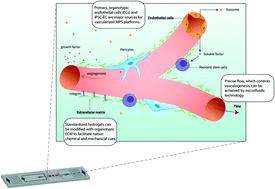Our official English website, www.x-mol.net, welcomes your feedback! (Note: you will need to create a separate account there.)
The vascular niche in next generation microphysiological systems
Lab on a Chip ( IF 6.1 ) Pub Date : 2021-08-16 , DOI: 10.1039/d1lc00530h Makena L Ewald 1 , Yu-Hsi Chen , Abraham P Lee , Christopher C W Hughes
Lab on a Chip ( IF 6.1 ) Pub Date : 2021-08-16 , DOI: 10.1039/d1lc00530h Makena L Ewald 1 , Yu-Hsi Chen , Abraham P Lee , Christopher C W Hughes
Affiliation

|
In recent years, microphysiological system (MPS, also known as, organ-on-a-chip or tissue chip) platforms have emerged with great promise to improve the predictive capacity of preclinical modeling thereby reducing the high attrition rates when drugs move into trials. While their designs can vary quite significantly, in general MPS are bioengineered in vitro microenvironments that recapitulate key functional units of human organs, and that have broad applications in human physiology, pathophysiology, and clinical pharmacology. A critical next step in the evolution of MPS devices is the widespread incorporation of functional vasculature within tissues. The vasculature itself is a major organ that carries nutrients, immune cells, signaling molecules and therapeutics to all other organs. It also plays critical roles in inducing and maintaining tissue identity through expression of angiocrine factors, and in providing tissue-specific milieus (i.e., the vascular niche) that can support the survival and function of stem cells. Thus, organs are patterned, maintained and supported by the vasculature, which in turn receives signals that drive tissue specific gene expression. In this review, we will discuss published vascularized MPS platforms and present considerations for next-generation devices looking to incorporate this critical constituent. Finally, we will highlight the organ-patterning processes governed by the vasculature, and how the incorporation of a vascular niche within MPS platforms will establish a unique opportunity to study stem cell development.
中文翻译:

下一代微生理系统中的血管生态位
近年来,微生理系统(MPS,也称为芯片器官或组织芯片)平台的出现,有望提高临床前模型的预测能力,从而降低药物进入试验时的高损耗率。虽然它们的设计可能差异很大,但总的来说,MPS 是体外微环境生物工程,概括了人体器官的关键功能单元,在人体生理学、病理生理学和临床药理学中具有广泛的应用。MPS 设备发展的关键下一步是在组织内广泛纳入功能性脉管系统。脉管系统本身是一个主要器官,向所有其他器官输送营养物质、免疫细胞、信号分子和治疗药物。它还在通过血管分泌因子的表达诱导和维持组织特性以及提供可支持干细胞的存活和功能的组织特异性环境(即血管生态位)方面发挥关键作用。因此,器官由脉管系统形成、维持和支持,而脉管系统反过来接收驱动组织特异性基因表达的信号。在这篇综述中,我们将讨论已发布的血管化 MPS 平台,并提出对寻求整合这一关键成分的下一代设备的考虑因素。最后,我们将重点介绍由脉管系统控制的器官模式过程,以及将血管生态位纳入 MPS 平台将如何为研究干细胞发育提供独特的机会。
更新日期:2021-08-16
中文翻译:

下一代微生理系统中的血管生态位
近年来,微生理系统(MPS,也称为芯片器官或组织芯片)平台的出现,有望提高临床前模型的预测能力,从而降低药物进入试验时的高损耗率。虽然它们的设计可能差异很大,但总的来说,MPS 是体外微环境生物工程,概括了人体器官的关键功能单元,在人体生理学、病理生理学和临床药理学中具有广泛的应用。MPS 设备发展的关键下一步是在组织内广泛纳入功能性脉管系统。脉管系统本身是一个主要器官,向所有其他器官输送营养物质、免疫细胞、信号分子和治疗药物。它还在通过血管分泌因子的表达诱导和维持组织特性以及提供可支持干细胞的存活和功能的组织特异性环境(即血管生态位)方面发挥关键作用。因此,器官由脉管系统形成、维持和支持,而脉管系统反过来接收驱动组织特异性基因表达的信号。在这篇综述中,我们将讨论已发布的血管化 MPS 平台,并提出对寻求整合这一关键成分的下一代设备的考虑因素。最后,我们将重点介绍由脉管系统控制的器官模式过程,以及将血管生态位纳入 MPS 平台将如何为研究干细胞发育提供独特的机会。



























 京公网安备 11010802027423号
京公网安备 11010802027423号